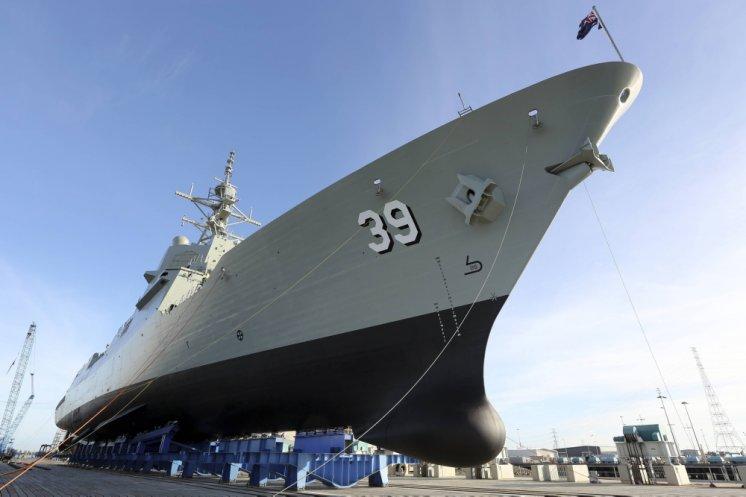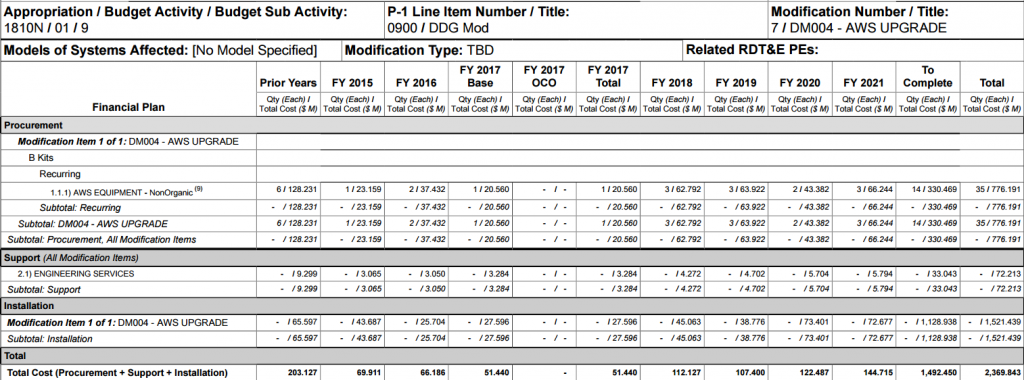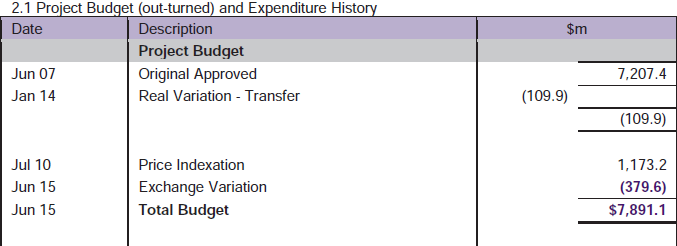An upgrade for the Air Warfare Destroyer—already?
Posted By James Mugg on September 14, 2016 @ 11:00

Analysing Australian defence expenditures is like a game of Battleship [1]. Occasionally you’ll score a hit, but attempting to understand a given acquisition often results in an ineffectual splash. A big part of the problem is the lack of official information, especially about future acquisitions. By contrast, the American system is a model of transparency and often provides more clues into Australian acquisitions than the Australian government does.
The Integrated Investment Program [2] (IIP), released alongside the 2016 Defence White Paper, lists current and future defence projects into the 2030s. While touted as providing a new level of transparency, it lacks the detail [3] required for robust accountability. For example, the IIP allocates AU$4-5 billion to upgrades for the AWD combat system between 2017 and 2028. It doesn’t mention what the upgrades will entail, how the cost will be spread across that 11 years, or even what enhancements are sought. My new ASPI report (PDF) [4], released today, tries to fill in the missing details. Tellingly, most of the data in the analysis came from overseas sources.
It’s worth investigating because the IIP figure seems inexplicably high. Thanks to the Australian National Audit Office’s (ANAO) 2014 AWD audit [5], we know the three Aegis combat systems acquired for the AWDs cost AU$1.3 billion, less than a third of the IIP upgrade cost estimate. That’s the beginning and end of the story as far as official Australian sources go. But Aegis is a US Navy system, and the US publishes eye-watering quantities of defence acquisition data, so we can examine what the USN is doing with its Aegis equipped ships.
The USN is modernising their Arleigh Burke class destroyers, including upgrades to the Aegis combat system. Figure 1 breaks down the costs and quantities for upgrading the Arleigh Burkes’ weapon system (an element of the overall Aegis combat system), as well as installation and support costs, by year out to 2021. The same level of detail is available for all aspects of the Arleigh Burke modernisation program.
Figure 1

Source: USN Budget FY2017 Other Procurement, Navy (BA-1) [6]
A high level of transparency is available across the US Defense establishment; through annual budget reports published by the Navy [7], Air Force [8], Army [9] and the Department of Defense Comptroller [10]. The US also publishes foreign military sales approvals online, such as the approval for up to US$275 million [11]worth of sustainment for Australia’s AWDs. And the US Government Accountability Office performs similar functions as the ANAO, and its annual Assessments of Selected Weapon Programs [12] is a close analogue of the ANAO’s Major Project Reports.
By contrast, Australia’s annual Defence portfolio budget statement lists only the top 30 acquisition projects, along with past and planned expenses. Table 1 below reproduces data for the 2016-17 Budget’s [13] top three acquisitions: P-8A Poseidon, F-35A Joint Strike Fighter, and Hobart class Air Warfare Destroyer (AWD).
Table 1

Source: 2016-17 Defence Budget [13], Table 71
The accompanying project descriptions provide some additional information, such as the number of platforms to be acquired and milestones for the next financial year. Of the AWDs, the budget says that the first of the three is planned to be delivered by the end of the financial year.
For most major Australian defence projects, that’s about all that’s disclosed. There’s no mention of over how many years the remaining budget will be spent and sparse information about when the capability will become operational.
More information can be found in the annual ANAO Major Projects Report [14], which examines 25 to 30 significant ongoing Defence projects. There are pages of schedules, budgets (Table 2 below), risk analyses, contract details and more on each selected project. Some projects receive a more thorough examination in focused performance audits, as was the case with the 2014 Air Warfare Destroyer audit [5].
Table 2

Source: ANAO Major Projects Report 2014-15, AWD Financial Performance
ANAO reports are the richest source of information about Australian defence projects, albeit with limitations. It’s unfortunate that the best data on Defence’s projects come from an external organisation, but more transparent self-reporting wouldn’t make the ANAO superfluous. The best outcome from an accountability perspective would be more transparent self-reporting, in addition to exhaustive auditing.
You’ll have to read the new paper for the grisly details, but the summary is that Australia’s AWDs have taken longer to build than the Aegis system has taken to evolve. Current plans have the AWDs being delivered with an earlier generation Aegis system than new-build American ships, then being taken offline for an expensive upgrade less than a decade after delivery. It also has implications for force preparedness, since the RAN’s Guided Missile Frigates, which could provide stopgap capacity, will have been retired when the upgrade occurs.
But you wouldn’t know any of that from the IIP or any other official source of information. It seems that transparency in Australian defence procurement is more honoured in the breach than the observance.
Article printed from The Strategist: https://aspistrategist.ru
URL to article: /upgrade-air-warfare-destroyer-already/
URLs in this post:
[1] Battleship: https://en.wikipedia.org/wiki/Battleship_(game)
[2] Integrated Investment Program: http://www.defence.gov.au/WhitePaper/Docs/2016-Defence-Integrated-Investment-Program.pdf
[3] lacks the detail: https://aspistrategist.ru/the-kinda-sort-of-integrated-investment-program/
[4] new ASPI report (PDF): https://www.aspistrategist.ru/publications/awd-combat-system-an-upgrade-for-the-aegis/SI109_AWD.pdf
[5] AWD audit: https://www.anao.gov.au/work/performance-audit/air-warfare-destroyer-program
[6] Other Procurement, Navy (BA-1): http://www.secnav.navy.mil/fmc/fmb/Documents/17pres/OPN_BA1_BOOK.pdf
[7] Navy: http://www.secnav.navy.mil/fmc/fmb/Pages/Fiscal-Year-2017.aspx
[8] Air Force: http://www.saffm.hq.af.mil/budget/index.asp
[9] Army: http://www.asafm.army.mil/offices/BU/BudgetMat.aspx?OfficeCode=1200
[10] Department of Defense Comptroller: http://comptroller.defense.gov/Budget-Materials/
[11] up to US$275 million : http://www.dsca.mil/major-arms-sales/australia-hobart-class-destroyer-sustainment
[12] Assessments of Selected Weapon Programs: http://www.gao.gov/products/GAO-16-329SP
[13] 2016-17 Budget’s: http://www.defence.gov.au/Budget/16-17/
[14] Major Projects Report: https://www.anao.gov.au/work/major-projects-report/2014-15-major-projects-report
Click here to print.